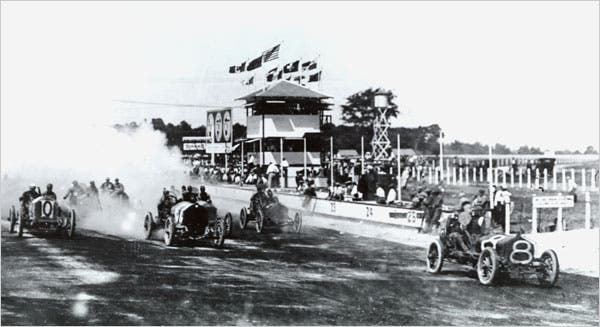Fortune Shines Bright on Bicycle Salesman

Every year race car enthusiasts pay tribute to an Indiana car salesman with an eye disorder who turned a bright invention into a thriving headlight business.
Carl Fisher was born in 1874 with a severe astigmatism that made it hard to study, and he dropped out of grade school at the age of 12. During the next five years he became a bicycle enthusiast and injured himself in stunts that curtailed his riding career.
After getting his fingers dirty laying street bricks and selling newspapers off of trains, Fisher found his calling in the world of sales promotions. He and his brothers opened a successful bicycle shop and built the business on his flare for the dramatic.
Once Fisher donned a padded suit and rode a bicycle on a tightrope over a busy Indianapolis street. Another time he dropped a bicycle from the city's tallest building, drawing enormous crowds and the ire of local police.
Auto dealer extraordinaire
Just as the bicycle craze abated in the early 1890s, America's love affair with the automobile blossomed. Fisher hopped on the horseless bandwagon and become one of the first auto dealers in the country.
Fisher promoted the dealership by strapping a car to a hot air balloon and flying it across town. He landed and drove back to enthusiastic crowds. The stunt involved some big-league slight of hand, however. Fisher removed the engine before strapping it to the balloon and placed a second vehicle at his landing site.
Fisher's fortunes skyrocketed when an inventor knocked on his door and demonstrated a new type of automobile headlamp. Until then, headlamps consisted of open gas flames or candles that tended to snuff out in bad weather. The inventor discovered a way to contain an acetylene torch in a sealed lamp. Fisher named it "Prest-O-Lite."
Producing the unstable gas required nerves of steel, however. Pret-O-Lite facilities were located in downtown Indianapolis next to a sauerkraut plant. In 1907, the facility exploded and showed the block with enough condiments for every frankfurter in the city.
The facility was relocated outside town and sold two years later for the princely sum of $9 million. Fisher invested some of the money in a young engineer's patent for vehicle starter systems, which ironically fueled the demise of his former Prest-O-Lite headlamps.
America's motor speedway
Other funds went to build a racetrack near the Prest-O-Lite facility. Workers laid tons of bricks to create the two-and-a-half mile track. Officially known as the Indianapolis Motor Speedway, locals simply called it The Brickyard.
The first Indy 500 race took place on Memorial Day in 1911. Barney Oldfield, Fisher's partner in the auto dealership, eventually became the first driver to clock more than 100 miles per hour.
Good fortune continued shine on the young entrepreneur when he sunk money into a remote Florida swampland and turned it into Miami Beach. Then, he persuaded federal planners to build the Dixie Highway from Canada to Florida. The resort became an exclusive enclave for magnates like Henry Ford.
Fisher also had a hand in building the Lincoln Highway, the first transcontinental road in the United States. His entire fortune was lost at the onset of the Great Depression. He was 55.
Sources: Indiana Historical Society, Lost Indiana website
Article by Jay Alling, editor of Sensible Driver. Write to jay@sensibledriver.com.